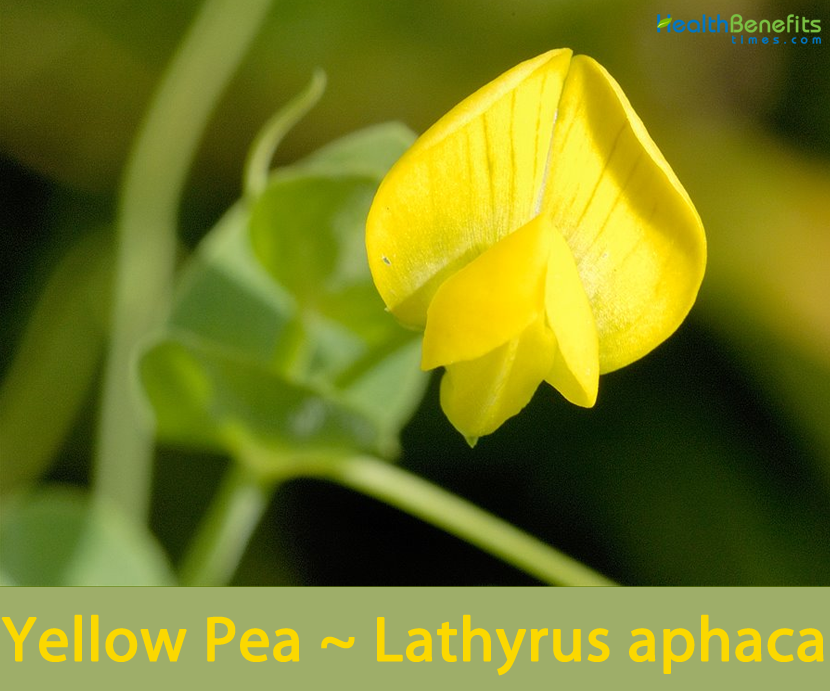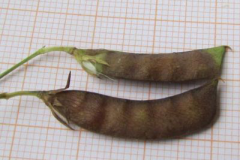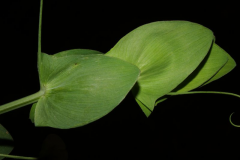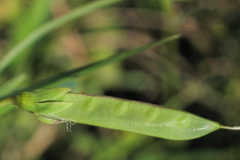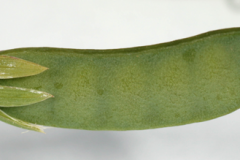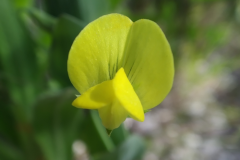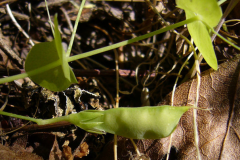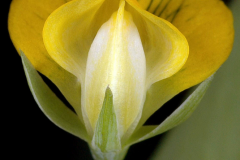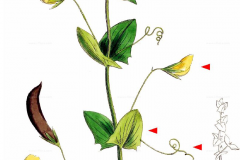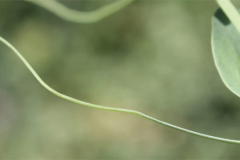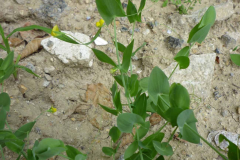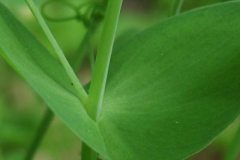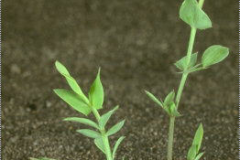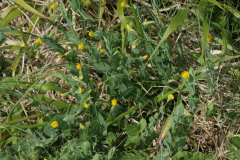| Yellow Pea Quick Facts | |
|---|---|
| Name: | Yellow Pea |
| Scientific Name: | Lathyrus aphaca |
| Origin | Western and Southern Europe, southern part of Central Europe, northern parts of Africa as well as in South-Western and Central Asia |
| Colors | Initially green turning to dull greenish or brownish as they mature |
| Shapes | Straight or incurved glabrous legumes that are 2- 4 cm long and 3-5 mm wide with 6-8 seeds. |
| Taste | Sweet, slightly nutty, and grassy flavor |
| Name | Yellow Pea |
|---|---|
| Scientific Name | Lathyrus aphaca |
| Native | Mostly occurs in Western and Southern Europe, southern part of Central Europe, northern parts of Africa as well as in South-Western and Central Asia and introduced in North America, where it has scattered occurrences, mainly in the south and the west. In New England it has been collected only in Massachusetts |
| Common Names | Yellow vetchling, Yellow pea, Yellow Vetch, Yellow peavine, Yellow-Flowered Pea |
| Name in Other Languages | Albanian: Sygjarpëri, vingjër Arabic: Bîqîyah, Hhamâm el burg, jalban eafqa (جلبان عفقة) Assamese: Bon-motor Basque: Astailarra, Astailar Bulgarian: bezlichno sekirche (безлично секирче), kopielistno sekirche (копиелистно секирче), zhŭlto sekirche (жълто секирче) Catalan: Gerdell, Banya de cabra, Fesolet, Galavars menut, Inflabou, Tapissot bord Croatian: Vitičasta kukavičica Czech: Hrachor bezlistý, Hrachor pa, hrachor pačočkový Danish: Bladløs fladbælg Dutch: Naakte lathyrus English: Yellow vetchling, Yellow pea, Yellow Vetch, Yellow peavine, Yellow-Flowered Pea Finnish: Korvakenätkelmä French: Gesse aphaca, Gesse sans feuille, Gesse Aphylle, Gesse sans feuilles, pois de serpent German: Rankenplatterbse, Ranken Platterbse, nackte Platterbse, Hebrew: Tofach matzui, טֹפַח מָצוּי Hindi: Jangli Matter (जंगली मटर), Janglimatar, Pili Matter Hungarian: Levéltelen lednek Italian: Afaga, Cicerchia senza foglie, Melagra, Pitine, Veccia bastarda, cicerchia bastarda, fior galletto, latiro afaga, majorella, mullaghera, vetriolo, Afaca Irish: Peasairín garraí Japanese: Takuyô-renri-sôu (タクヨウレンリソウ) Kabyle: Aḥbac n wezrem Kannada: Chkka thogari Latvian: Vītņu dedestiņa Macedonian: Bezlisten graor (безлистен граор) Nepali: Ban khesari (बन खेसरी) Occitan: Bésse, cese de loup, cése, guirgàlh, jerderic, jerjerèt Oriya: ମଟର Persian: خلر بیبرگ Portuguese: Chícharo-amarelo, Ervilha-olho-de-boneca, ervilhaca-silvestre Romanian: Linte galbenă Russian: China Bezlistochkovaya (чина безлисточковая) Serbian: bezlisni grahor (безлисни грахор), nokata (ноката), obični grahor (обични грахор), sjajnik (сјајник) Slovak: Hrachor bezlistý Slovene: Lečasti grahor Spanish: Afaca, Alverja Silvestre, afaga, alverja amarilla, alverja de burros, arvejo, arvexaca Swedish: Spjutvial, Pjutvial Turkish: Sar burçak, Sarı mürdümük Ukrainian: Cina bezlistočkova (чина безлисточкова) Upper Sorbian: Wobwitkowy hróšik Welsh: Ydbysen Felen, Ytbys Melyn, Ytbysen Felen |
| Plant Growth Habit | Medium to tall, slender trailing or scrambling, hairless annual plant |
| Growing Climates | Dry places on sand, gravel and chalk, man-made or disturbed habitats, cultivated fields, roadsides, dry lawns, transport route edges (especially along railway lines), in orchards, arable fields, fallows, waste lots, meadows, rocky limestone slopes, stream banks, marshy ground, disturbed steppe and gravel quarries. It is found mainly as a weed among crops and in gardens, rarely among shrubs and on herbaceous slopes |
| Plant Size | About 100 cm tall |
| Stem | Stems are pale green to glaucous, glabrous, angled in cross-section but lack wings |
| Leaf | True Leaves are absent. The seedling leaves have a pair of small leaflets, light-green to grey-green colored; the mature leaf is reduced to a simple, unbranched tendril. Stipules are 6-50 mm long and 5-40 mm wide, ovate-hastate to arrowhead in shape with two triangular lobes pointed outwards |
| Flowering season | June to August |
| Flower | Bisexual flowers are usually solitary (occasionally in pairs) and are lemon-yellow in color (often streaked with violet), measuring from 10–13 mm in length, and held on long (up to 50 mm) stalks branching from the leaf axils |
| Fruit Shape & Size | Straight or incurved glabrous legumes that are 2- 4 cm long and 3-5 mm wide with 6-8 seeds |
| Fruit Color | Initially green turning to dull greenish or brownish as they mature |
| Taste | Sweet, slightly nutty, and grassy flavor |
| Propagation | By seed in early summer or early autumn and Division in spring |
| Culinary Uses |
|
| Season | August to September |
Plant Description
Yellow Pea is a medium to tall, slender, trailing or scrambling, hairless annual plant that normally grows about 100 cm tall. The plant grows from a thin rootstock; it produces one to a few erect stems that often cling to surrounding vegetation by means of tendrils. The stems are pale green to glaucous, glabrous, angled in cross-section but lack wings. The plant is found growing in dry places on sand, gravel and chalk, man-made or disturbed habitats, cultivated fields, roadsides, dry lawns, transport route edges (especially along railway lines), in orchards, arable fields, fallows, waste lots, meadows, rocky limestone slopes, stream banks, marshy ground, disturbed steppe and gravel quarries. It is found mainly as a weed among crops and in gardens, rarely among shrubs and on herbaceous slopes.
Leaves
True Leaves are absent. The seedling leaves have a pair of small leaflets, light-green to grey-green colored; the mature leaf is reduced to a simple, unbranched tendril. Stipules are 6-50 mm long and 5-40 mm wide, ovate-hastate to arrowhead in shape with two triangular lobes pointed outwards. The stems and stipules are glabrous and unbranched, prehensile tendrils extend beyond the stipules from the axils.
Flowers
The bisexual flowers are usually solitary (occasionally in pairs) and are lemon-yellow in color (often streaked with violet), measuring from 10–13 mm in length, and held on long (up to 50 mm) stalks branching from the leaf axils. The banner is about 1.5 times as long as the calyx. The wings and keel are roughly equal in length to the banner. The calyx measures 7-10 mm long with linear to narrowly oblong-lanceolate teeth about twice as long as the calyx tube. The flowers, which are, have 10 stamens and 1 style. Flowering normally takes place in between June to August. Flowers are diploid, with 14 chromosomes.
Fruit
Fertile flowers are followed by straight or incurved glabrous legumes that are 2- 4 cm long and 3-5 mm wide with 6-8 seeds. Fruits are initially green turning to dull greenish or brownish as they mature. Seeds are ellipsoid to globose, usually flattish with a glossy, smooth, dark purple-brown to black surface, sometimes spotted to marbled. The fruits are eaten as a supplement to diets in some parts of South Asia but seed contains a toxic amino-acid in large quantities, which can cause a very serious disease of the nervous system known as ‘lathyrism’. When taken in small quantities it is stated that the seeds are safe and highly nutritious.
Some Traditional uses
- The ripe seeds are said to be antibacterial and narcotic.
- They are used in the treatment of toothache.
- The plant is known to contain flavonoids, tannins, glycosides, alkaloids and terpenoids.
- The flowers are resolvent.
Other Facts
- The seed is said to be perfectly safe and very nutritious in small quantities.
- The fruits are eaten as a supplement to diets in some parts of South Asia but are narcotic and potentially toxic in large quantities.
- It can be an aggressive agricultural weed, infesting mainly wheat, but also other crops, such as sugarcane in Pakistan.
- Black dye is obtained from the plant when iron is used as the mordant.
- Plant is cultivated for human consumption in Asia and Mediterranean.
- It is a problematic weed in the rice-wheat cropping system of Pakistan.
- Its germination occurs from October-November to April and reaches maturity before wheat crops during early April.
- It drops its seeds in field before wheat harvest thus increasing the soil weed seed bank and provoking the trouble in subsequent crop of winter season.
- Various environmental factors such as moisture stress, light, temperature, soil acidity, salinity, pH and depth of seeds burial directly or indirectly affect weeds seeds germination.
Precautions
- The seed contains a toxic amino-acid which, in large quantities, can cause a very serious disease of the nervous system known as ‘lathyrism’.
- Some of the common side effects are paralysis of the muscles below the knees, pains in the back, followed by weakness and stiffness of the legs and progressive locomotive incoordination.
References:
https://www.itis.gov/servlet/SingleRpt/SingleRpt?search_topic=TSN&search_value=25838#null
https://npgsweb.ars-grin.gov/gringlobal/taxon/taxonomydetail?id=21544
https://pfaf.org/user/Plant.aspx?LatinName=Lathyrus+aphaca
https://www.cabi.org/isc/datasheet/115145
https://gd.eppo.int/taxon/LTHAP
https://en.wikipedia.org/wiki/Lathyrus_aphaca
http://www.theplantlist.org/tpl1.1/record/ild-7745
https://www.flowersofindia.net/catalog/slides/Yellow%20Pea.html
https://www2.dijon.inrae.fr/hyppa/hyppa-a/lthap_ah.htm
https://tennessee-kentucky.plantatlas.usf.edu/plant.aspx?id=3556
https://temperate.theferns.info/plant/Lathyrus+aphaca
http://ibuflora.ibu.edu.tr/en/species/lathyrus-aphaca
https://plants.usda.gov/home/plantProfile?symbol=LAAP2


